High-Frequency Sea-Level Cycle Reconstruction and Vertical Distribution of Carbonate Ramp Shoal Facies Dolomite Reservoir in Gucheng Area, East Tarim Basin
Abstract
:1. Introduction
2. Geological Background
3. Materials and Methods
3.1. Experimental Materials and Methods
3.2. High-Frequency Sea-Level Curve Reconstruction Methods
4. Experimental Results
5. Discussion
5.1. Correlation by Fischer Plot
5.2. Reconstruction of Carbon Isotope Comprehensive Curve
5.3. Verification of Carbon Isotope Comprehensive Curve
5.4. Relation between High-Frequency Sea-Level Changes and Reservoir Characteristics
5.5. Limitations and Future Work
6. Conclusions
Author Contributions
Funding
Institutional Review Board Statement
Informed Consent Statement
Data Availability Statement
Acknowledgments
Conflicts of Interest
References
- Xiao, J.; Wang, L.; Chen, M.; Chen, Z.; Zhou, J.; Chen, P. Multiple scale fluctuations of the Early Triassic sea level and its influence on reservoirs in the Sichuan Basin. Pet. Geol. Exp. 2017, 39, 618–624. [Google Scholar]
- Yang, D.; Huang, Y.; Chen, Z.; Huang, Q.; Ren, Y.; Wang, C. A Python Code for Automatic Construction of Fischer Plots Using Proxy Data. Sci. Rep. 2021, 11, 10518. [Google Scholar] [CrossRef] [PubMed]
- He, F.; Lin, C.; Liu, J.; Zhang, Z.; Zhang, J.; Yan, B.; Qu, T. Migration of the Cambrian and Middle-Lower Ordovician carbonate platform margin and its relation to relative sea level changes in southeastern Tarim Basin. Oil Gas Geol. 2017, 38, 711–721. [Google Scholar]
- Read, J.F. Carbonate Platforms of Passive (Extensional) Continental Margins: Types, Characteristics and Evolution. Tectonophysics 1982, 81, 195–212. [Google Scholar] [CrossRef]
- Mei, M. From vertical stacking pattern of cycles to discerning and division of sequences: The third advance in sequence stratigraphy. J. Palaeogeogr. 2011, 13, 37–54. [Google Scholar]
- Wang, Q.; Han, J.; Li, H.; Sun, Y.; He, H.; Ren, S. Carbonate sequence architecture, sedimentary evolution and sea level fluctuation of the Middle and Lower Ordovician on outcrops at the northwestern margin of Tarim Basin. Oil Gas Geol. 2019, 40, 835–850, 916. [Google Scholar]
- Zhang, Y.; Chen, J.; Zhou, J.; Yuan, Y. Sedimentological Sequence and Depositional Evolutionary Model of Lower Triassic Carbonate Rocks in the South Yellow Sea Basin. China Geol. 2019, 2, 301–314. [Google Scholar] [CrossRef]
- Jamaludin, S.N.F.; Pubellier, M.; Menier, D. Structural Restoration of Carbonate Platform in the Southern Part of Central Luconia, Malaysia. J. Earth Sci. 2018, 29, 155–168. [Google Scholar] [CrossRef]
- Li, W.; Zhang, J.; Hao, Y.; Ni, C.; Tian, H.; Zeng, Y.; Yao, Q.; Shan, S.; Cao, J.; Zou, Q. Characteristics of carbon and oxygen isotopic, paleoceanographic environment and their relationship with reservoirs of the Xixiangchi Formation, southeastern Sichuan Basin. Acta Geol. Sin. 2019, 93, 487–500. [Google Scholar]
- Bao, Z.; Jin, Z.; Sun, L.; Wang, Z.; Wang, Q.; Zhang, Q.; Shi, X.; Li, W.; Wu, M.; Gu, Q.; et al. Sea-Level Fluctuation of the Tarim Area in the Early Paleozoic: Respondence from Geochemistry and Karst. Acta Geol. Sin. 2006, 80, 366–373. [Google Scholar]
- Gao, D.; Lin, C.; Hu, M.; Huang, L. Using Spectral Gamma Ray Log to Recognize High-frequency Sequences in Carbonate Strata: A case study from the Lianglitage Formation from Well T1 in Tazhong area, Tarim Basin. Acta Sedimentol. Sin. 2016, 34, 707–715. [Google Scholar]
- Zong, Y.; Shen, Y.; Qin, Y.; Jin, J.; Liu, J.; Tong, G.; Zheng, J.; Zhang, Y. High Frequency Cyclic Sequence Based on the Milankovitch Cycles in Upper Permian Coal Measures in Panxian, Western Guizhou Province. Geol. J. China Univ. 2019, 25, 598–609. [Google Scholar]
- Wang, G.; Deng, Q.; Tang, W. The application of spectral analysis of logs in depositional cycle studies. Pet. Explor. Dev. 2002, 29, 93–95. [Google Scholar]
- Zhang, Z.; Zhang, C.; He, Z. Recognition of Stratigraphic High-frequency Cyclical Properties with Sliding Window Spectrum of Logs. J. Oil Gas Technol. 2003, 25, 56–58. [Google Scholar]
- Yi, H. Application of well log cycle analysis in studies of sequence stratigraphy of carbonate rocks. J. Palaeogeogr. 2011, 13, 456–466. [Google Scholar]
- Shao, C.; Fan, T.; Sun, Y. A case study on Yaojia formation of Changyuan district: Fischer plot analysis based on natural gamma data. Resour. Ind. 2013, 15, 64–70. [Google Scholar]
- Liu, Y.; Meng, X. The sea-level change forcing cycies of oolitic carbonate and cycioc-hrological applications. Chin. J. Geol. 1999, 4, 442–450. [Google Scholar]
- Amour, F.; Mutti, M.; Christ, N.; Immenhauser, A.; Benson, G.S.; Agar, S.M.; Tomás, S.; Kabiri, L. Outcrop Analog for an Oolitic Carbonate Ramp Reservoir: A Scale-Dependent Geologic Modeling Approach Based on Stratigraphic Hierarchy. AAPG Bull. 2013, 97, 845–871. [Google Scholar] [CrossRef]
- Ma, X.; Yang, Y.; Wen, L.; Luo, B. Distribution and exploration direction of medium- and large-sized marine carbonate gas fields in Sichuan Basin, SW China. Pet. Explor. Dev. 2019, 46, 1–13. [Google Scholar] [CrossRef]
- Chen, Y.; Zhang, J.; Li, W.; Pan, L.; She, M. Lithofacies paleogeography, reservoir origin and distribution of the Cambrian Longwangmiao Formation in Sichuan Basin. Mar. Orig. Pet. Geol. 2020, 25, 171–180. [Google Scholar]
- Wang, Z.; Yang, H.; Qi, Y.; Chen, Y.; Xu, Y. Ordovician gas exploration breakthrough in the Gucheng lower uplift of the Tarim Basin and its enlightenment. Nat. Gas Ind. 2014, 34, 1–9. [Google Scholar]
- Zhang, Y.; Li, Q.; Zheng, X.; Li, Y.; Shen, A.; Zhu, M.; Xiong, R.; Zhu, K.; Wang, X.; Qi, J.; et al. Types, evolution and favorable reservoir facies belts in the Cambrian-Ordovician platform in Gucheng-Xiaotang area, eastern Tarim Basin. Acta Pet. Sin. 2021, 42, 447–465. [Google Scholar]
- Liu, Y.; Hou, J.; Li, Y.; Dong, Y.; Ma, X.; Wang, X. Characterization of Architectural Elements of Ordovician Fractured-cavernous Carbonate Reservoirs, Tahe Oilfield, China. J. Geol. Soc. India 2018, 91, 315–322. [Google Scholar] [CrossRef]
- Chen, H.; Zhong, Y.; Hou, M.; Lin, L.; Dong, G.; Liu, J. Sequence Styles and Hydrocarbon Accumulation Effects of Carbonate Rock Platform in the Changxing-Feixianguan Formations in the Northeastern Sichuan Basin. Oil Gas Geol. 2009, 30, 539–547. [Google Scholar]
- Zhu, Y.; Ni, X.; Liu, L.; Qiao, Z.; Chen, Y.; Zheng, J. Depositional Differentiation and Reservoir Potential and Distribution of Ramp Systems during Post-rift Period: An example from the Lower Cambrian Xiaoerbulake Formation in the Tarim Basin, NW China. Acta Sedimentol. Sin. 2019, 37, 1044–1057. [Google Scholar]
- Huang, X.; Fu, M.; Zhao, L.; Zhou, W.; Wang, Y. Identification and sgnificance of meter-scale cycle of carbonate rocks in Mishrif Formation, HF Oilfield, Irag. Mar. Orig. Pet. Geol. 2019, 24, 44–50. [Google Scholar]
- Handford, C.R.; Loucks, R.G. Carbonate Depositional Sequences and Systems Tracts–Responses of Carbonate Platforms to Relative Sea-Level Changes: Chapter 1. 1993. Available online: http://archives.datapages.com/data/specpubs/seismic2/data/a168/a168/0001/0000/0003.htm (accessed on 9 May 2021).
- Feng, J.; Zhang, Y.; Zhang, Z.; Fu, X.; Wang, H.; Wang, Y.; Liu, Y.; Zhang, J.; Li, Q.; Feng, Z. Characteristics and main control factors of Ordovician shoal dolomite gas reservoir in Gucheng area, Tarim Basin, NW China. Pet. Explor. Dev. 2022, 49, 45–55. [Google Scholar] [CrossRef]
- Zhang, J.; Hu, M.; Feng, Z.; Li, Q.; He, X.; Zhang, B.; Yan, B.; Wei, G.; Zhu, G.; Zhang, Y. Types of the Cambrian platform margin mound-shoal complexes and their relationship with paleogeomorphology in Gucheng area, Tarim Basin, NW. Pet. Explor. Dev. 2021, 48, 94–105. [Google Scholar] [CrossRef]
- Cao, Y.; Wang, S.; Zhang, Y.; Yang, M.; Yan, L.; Zhao, Y.; Zhang, J.; Wang, X.; Zhou, X.; Wang, H. Petroleum geological conditions and exploration potential of Lower Paleozoic carbonate rocks in Gucheng Area, Tarim Basin, China. Pet. Explor. Dev. 2019, 46, 1099–1114. [Google Scholar] [CrossRef]
- Zhang, J.; Feng, Z.; Li, Q.; Zhang, B. Evolution of Cambrian mound-beach gas reservoirs in Gucheng platform margin zone, Tarim Basin. Pet. Geol. Exp. 2018, 40, 655–661. [Google Scholar]
- Shen, A.; Fu, X.; Zhang, Y.; Zheng, X.; Liu, W.; Shao, G.; Cao, Y. A study of source rocks & carbonate reservoirs and its implication on exploration plays from Sinian to Lower Paleozoic in the east of Tarim Basin, northwest China. Nat. Gas Geosci. 2018, 29, 1–16. [Google Scholar]
- Ren, Y.; Zhang, J.; Qi, J.; Zhang, Y.; Zhang, B.; Liu, Y. Sedimentary characteristics and evolution laws of Cambrian-Ordovician carbonate rocks in tadong region. Pet. Geol. Oilfield Dev. Daqing 2014, 33, 103–110. [Google Scholar]
- Zhang, Y.; Gao, Z.; Li, J.; Zhang, B.; Gu, Q.; Lu, Y. Identification and distribution of marine hydrocarbon source rocks in the Ordovician and Cambrian of the Tarim Basin. Pet. Explor. Dev. 2012, 39, 285–294. [Google Scholar] [CrossRef]
- Jiang, M.; Zhu, J. Carbon and strontium isotopic characteristics of Ordovician carbonate rocks in the Tarim Basin and their responses to sea level changes. Sci. Sin. 2002, 32, 36–42. [Google Scholar]
- Zhao, G. Middle-Late Ordovician Sea-Level Changes in the Bachu Area, Tarim Basin, Xinjiang: Carbon, Oxygen and Strontium Isotope Records. Ph.D. Thesis, Jilin University, Changchun, China, 2013. [Google Scholar]
- Kaufman, A.J.; Knoll, A.H. Neoproterozoic Variations in the C-Isotopic Composition of Seawater: Stratigraphic and Biogeochemical Implications. Precambrian Res. 1995, 73, 27–49. [Google Scholar] [CrossRef]
- Hoefs, J. Stable Isotope Geochemistry, 6th ed.; Springer: Berlin, Germany, 2009. [Google Scholar]
- Liu, C.; Zhang, Y.; Li, H.; Cao, Y.; Zhao, Y.; Yang, M.; Zhou, B. Sequence stratigraphy classification and its geologic implications of Ordovician Yingshan formation in Gucheng area, Tarim basin. J. Northeast. Pet. Univ. 2017, 41, 82–96. [Google Scholar]
- Wenzel, B.; Joachimski, M.M. Carbon and Oxygen Isotopic Composition of Silurian Brachiopods (Gotland/Sweden): Palaeoceanographic Implications. Palaeogeogr. Palaeoclimatol. Palaeoecol. 1996, 122, 143–166. [Google Scholar] [CrossRef]
- Cramer, B.D.; Saltzman, M.R. Sequestration of 12C in the Deep Ocean during the Early Wenlock (Silurian) Positive Carbon Isotope Excursion. Palaeogeogr. Palaeoclimatol. Palaeoecol. 2005, 219, 333–349. [Google Scholar] [CrossRef]
- Fischer, A.G. The Lofer Cyclothem of the Alpine Triassic. In Symposium on cyclic sedimentation. Kans. State Geol. Surv. Bull. 1964, 169, 107–149. [Google Scholar]
- Read, J.F.; Goldhammer, R.K. Use of Fischer Plots to Define Third-Order Sea-Level Curves in Ordovician Peritidal Cyclic Carbonates, Appalachians. Geology 1988, 16, 895–899. [Google Scholar] [CrossRef]
- Sadler, P.M.; Osleger, D.A.; Montanez, I.P. On the Labeling, Length, and Objective Basis of Fischer Plots. J. Sediment. Res. 1993, 63, 360–368. [Google Scholar]
- Day, P.I. The Fischer Diagram in the Depth Domain: A Tool for Sequence Stratigraphy. J. Sediment. Res. 1997, 67, 982–984. [Google Scholar] [CrossRef]
- Guo, Y.; Wang, F.; Gan, F.; Yan, B. Forecasting of Spring Flow based on Moving Average Model and Exponential Smoothing Model. J. Hebei GEO Univ. 2020, 43, 19–25. [Google Scholar]
- Elderfield, H.; Greaves, M.J. The Rare Earth Elements in Seawater. Nature 1982, 296, 214–219. [Google Scholar] [CrossRef]
- Gromet, L.P.; Haskin, L.A.; Korotev, R.L.; Dymek, R.F. The “North American Shale Composite”: Its Compilation, Major and Trace Element Characteristics. Geochim. Cosmochim. Acta 1984, 48, 2469–2482. [Google Scholar] [CrossRef]
- Wilde, P.; Quinby-Hunt, M.S.; Erdtmann, B.D. The Whole-Rock Cerium Anomaly: A Potential Indicator of Eustatic Sea-Level Changes in Shales of the Anoxic Facies. Sediment. Geol. 1996, 101, 43–53. [Google Scholar] [CrossRef]
- Li, G. The Carbon Isotope Fluctuations and Its Paleoenvironmental Significance of the Upper Jurassic Bulk Carbonate from Amdo Area, Tibet. Ph.D. Thesis, Chengdu University of Technology, Chengdu, China, 2020. [Google Scholar]
- Yang, J.; Sun, W.; Wang, Z. Variations in Sr and C Isotopes and Ce Anomalies in Successions from China: Evidence for the Oxygenation of Neoproterozoic Seawater? Precambrian Res. 1999, 93, 215–233. [Google Scholar]
- Veizer, J.; Ala, D.; Azmy, K.; Bruckschen, P.; Buhl, D.; Bruhn, F.; Carden, G.A.; Diener, A.; Ebneth, S.; Godderis, Y. 87Sr/86Sr, Δ13C and Δ18O Evolution of Phanerozoic Seawater. Chem. Geol. 1999, 161, 59–88. [Google Scholar] [CrossRef]
- Haq, B.U.; Schutter, S.R. A Chronology of Paleozoic Sea-Level Changes. Science 2008, 322, 64–68. [Google Scholar] [CrossRef]
- Horacek, M.; Brandner, R.; Abart, R. Carbon Isotope Record of the P/T Boundary and the Lower Triassic in the Southern Alps: Evidence for Rapid Changes in Storage of Organic Carbon. Palaeogeogr. Palaeoclimatol. Palaeoecol. 2007, 252, 347–354. [Google Scholar] [CrossRef]
- Mazzullo, S.J.; Harris, P.M. An Overview of Dissolution Porosity Development in the Deep-Burial Environment, with Examples from Carbonate Reservoirs in the Permian Basin. West Tex. Geol. Soc. Midl. TX 1991, 89–91. [Google Scholar]

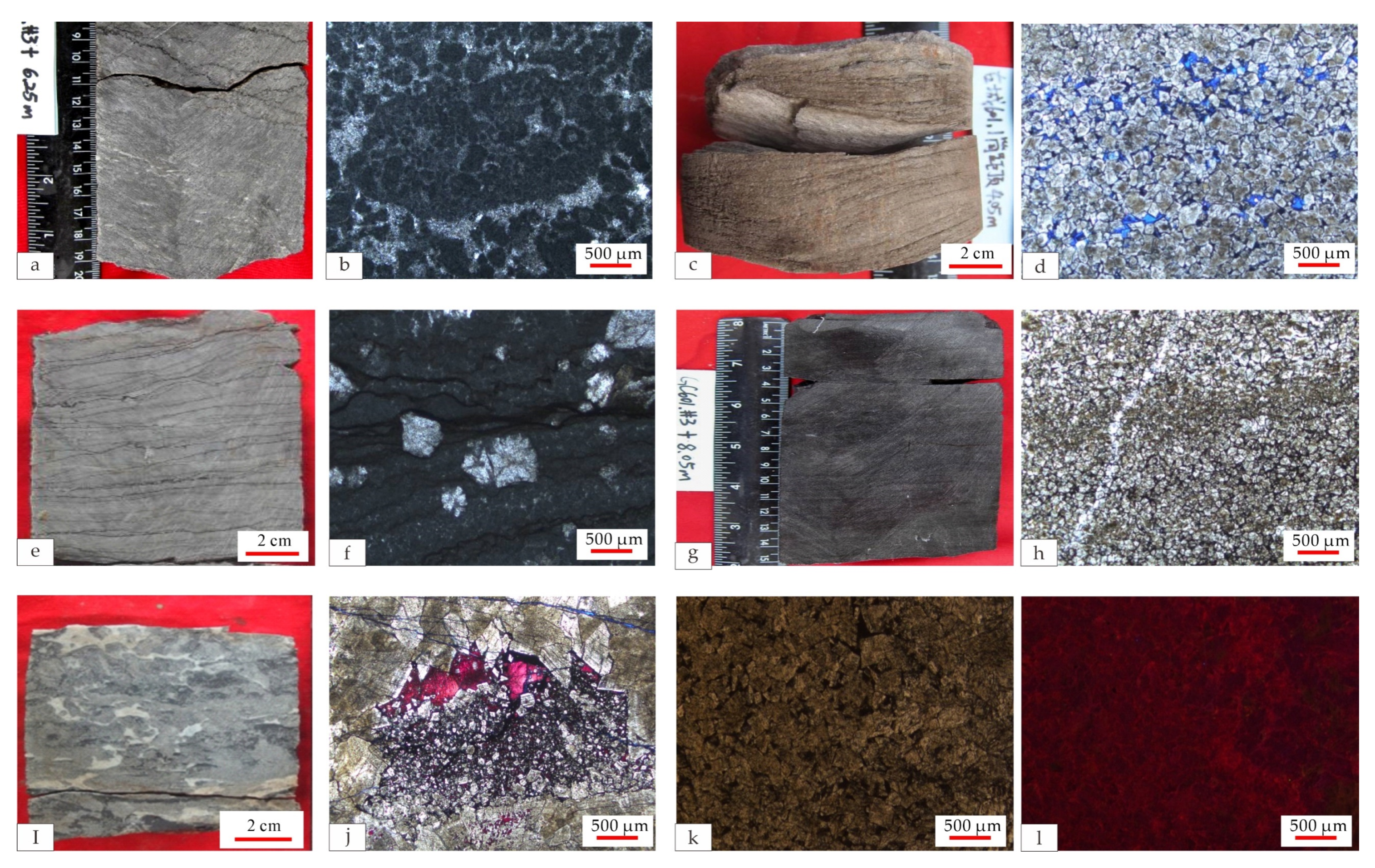
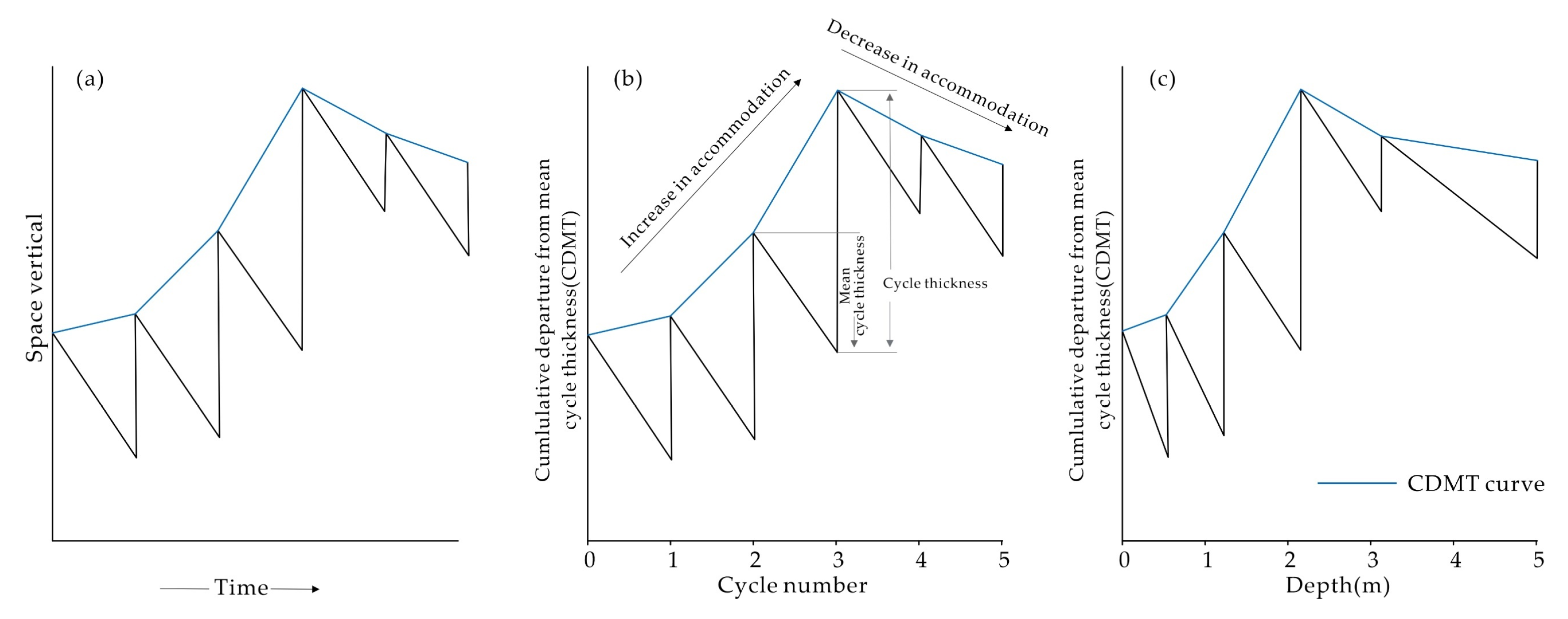
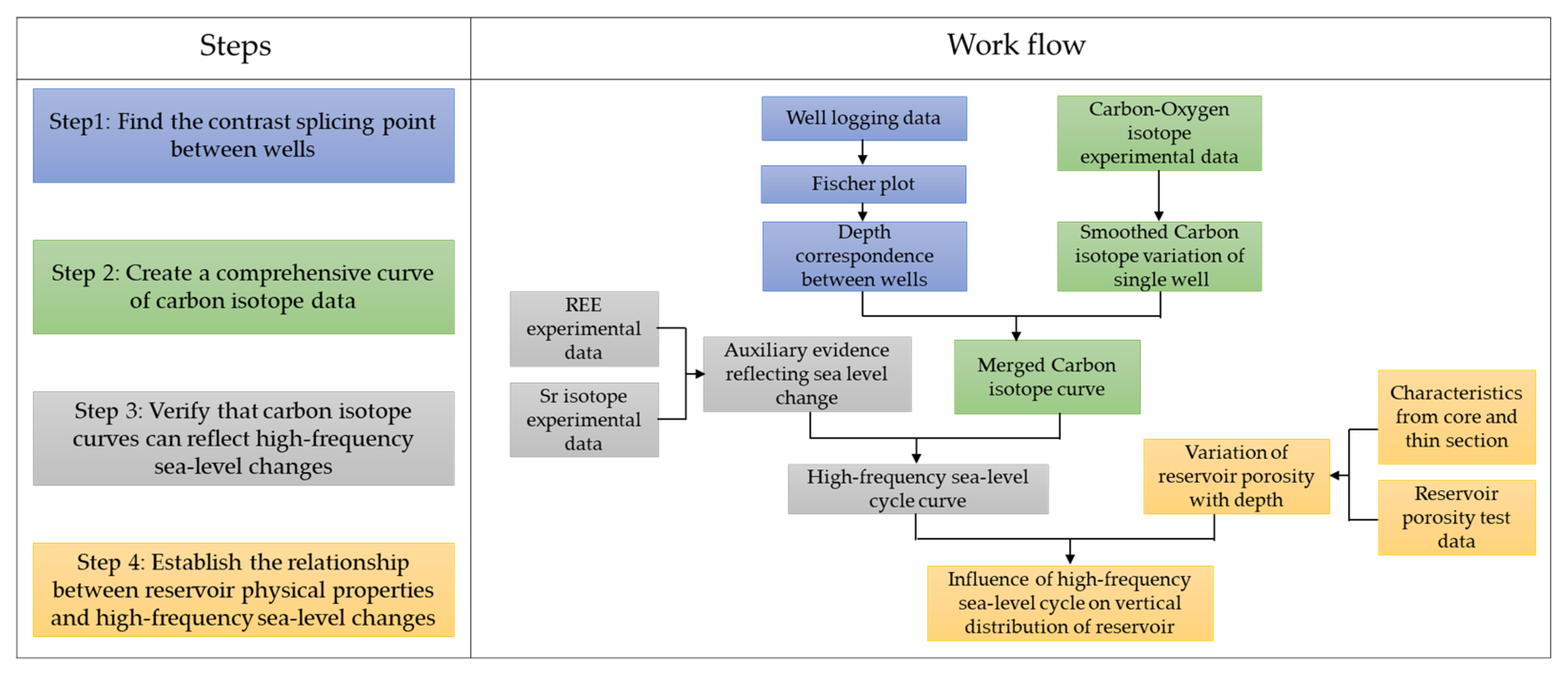



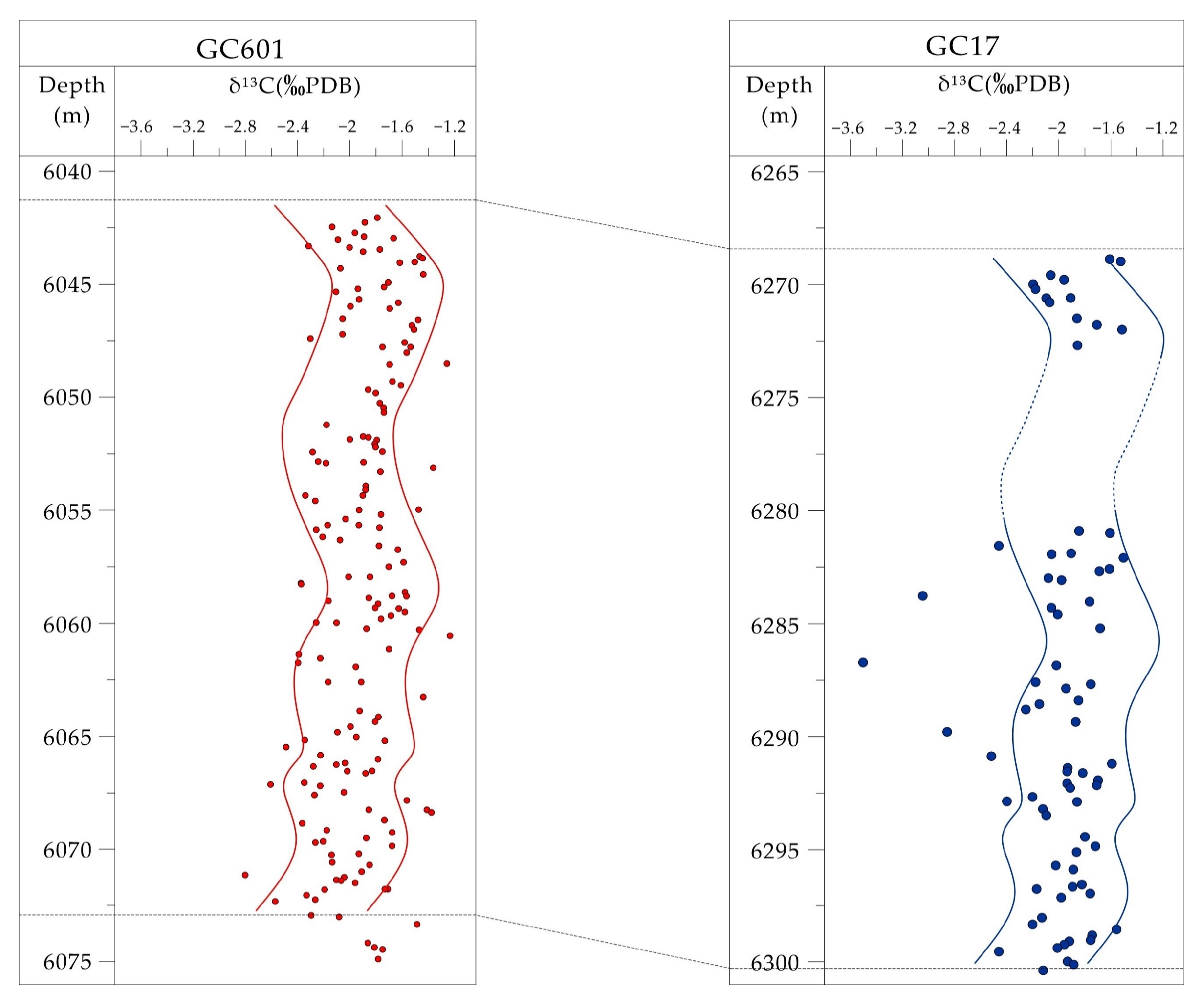


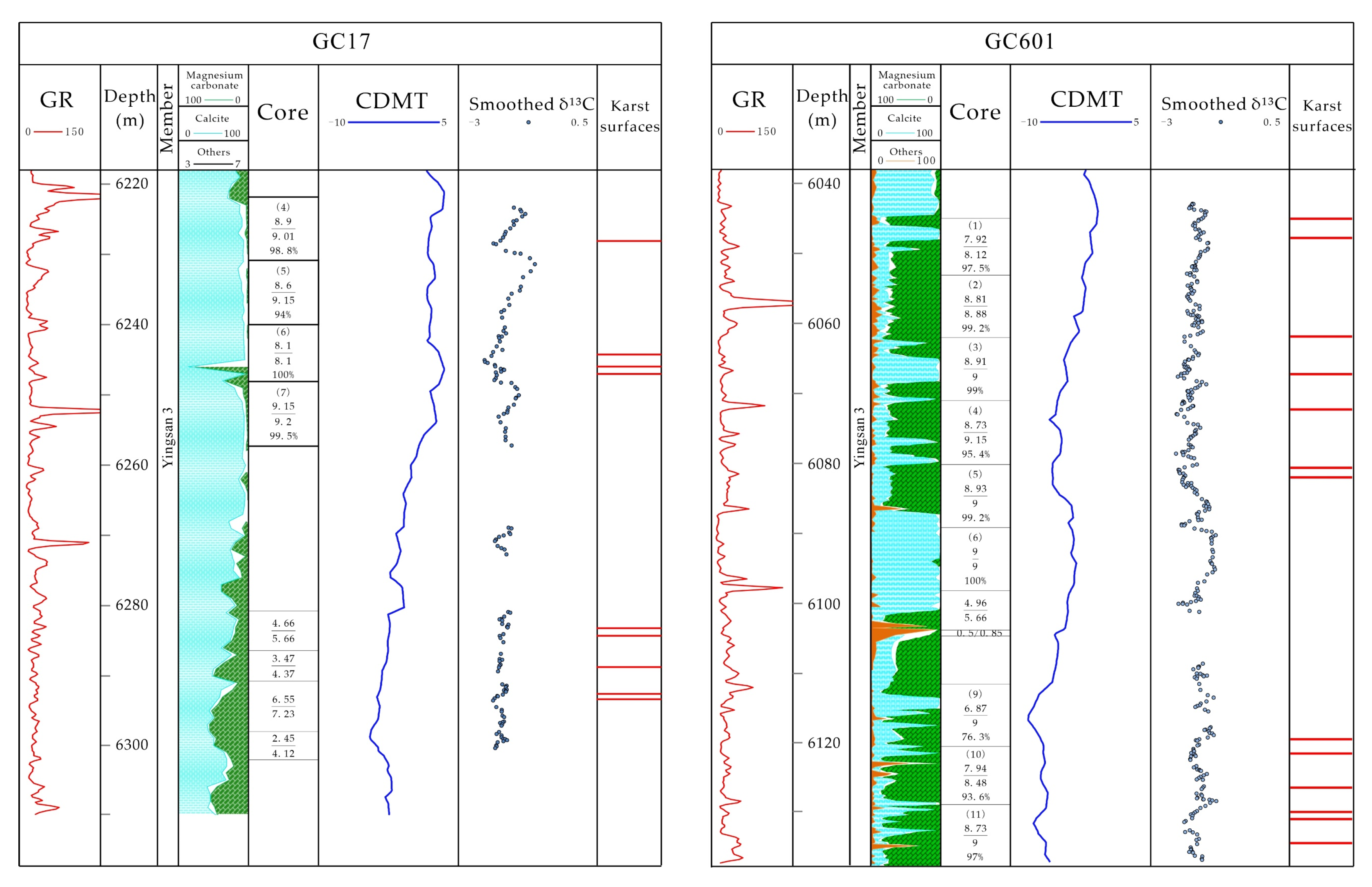

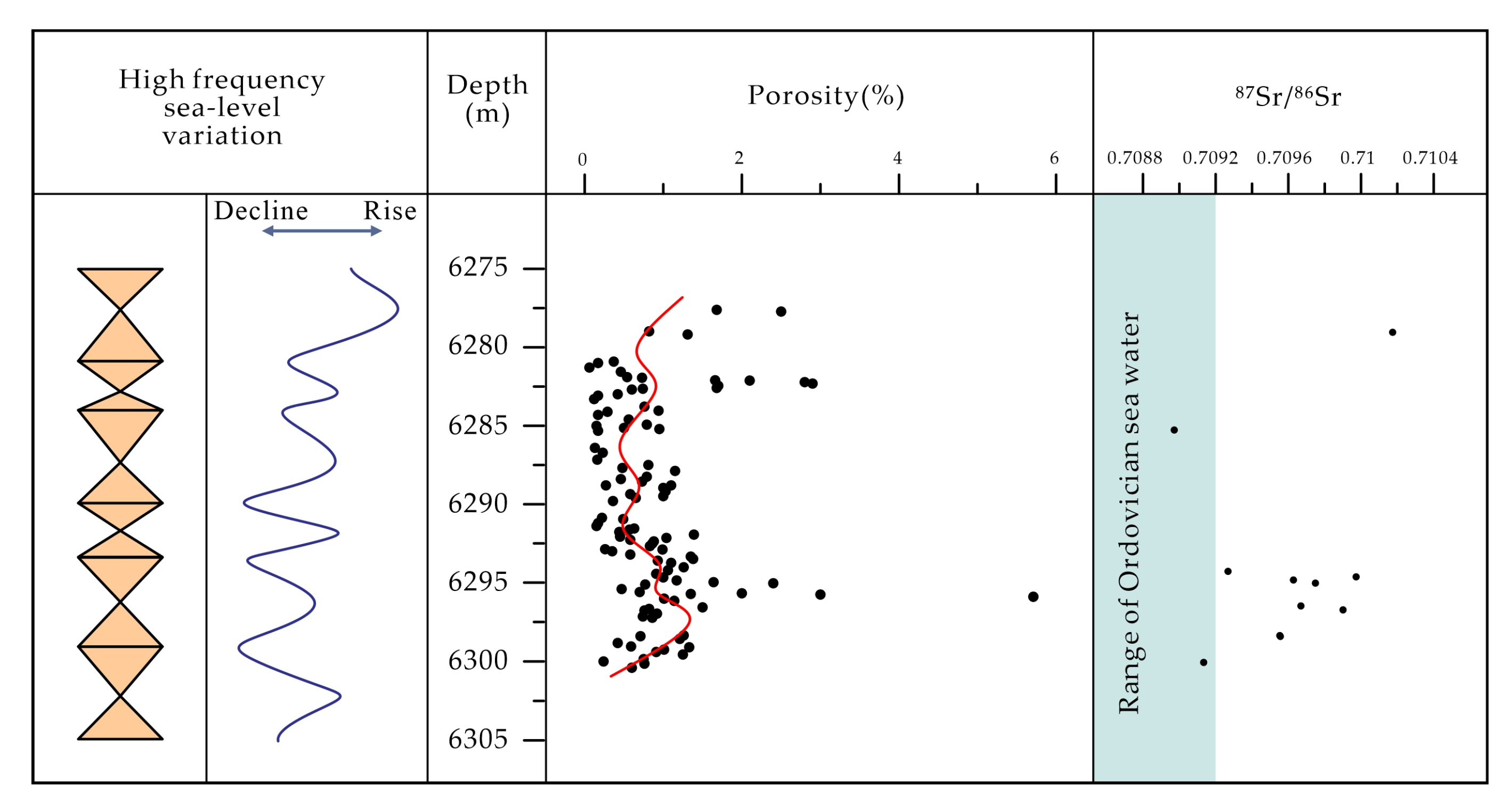
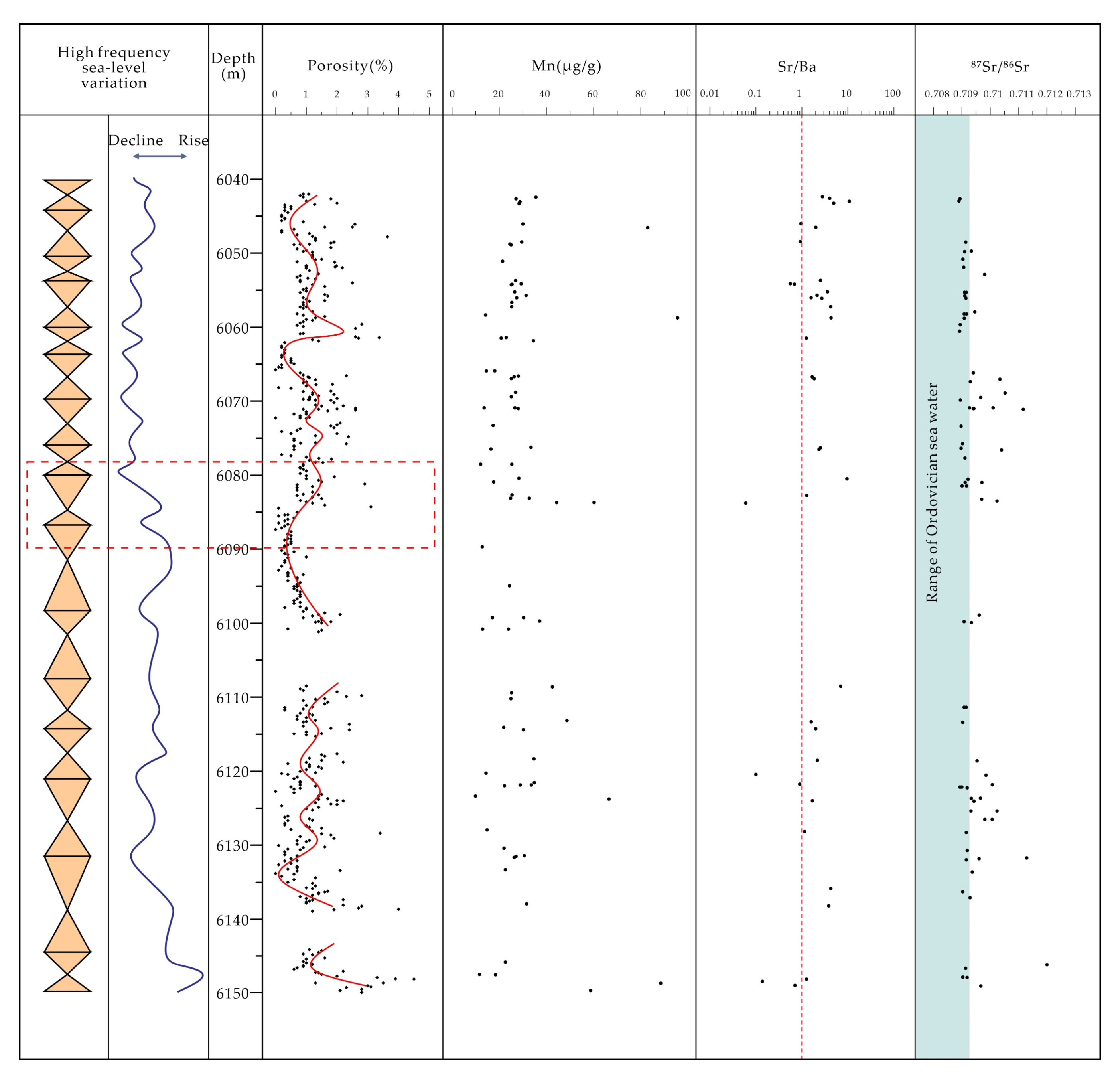

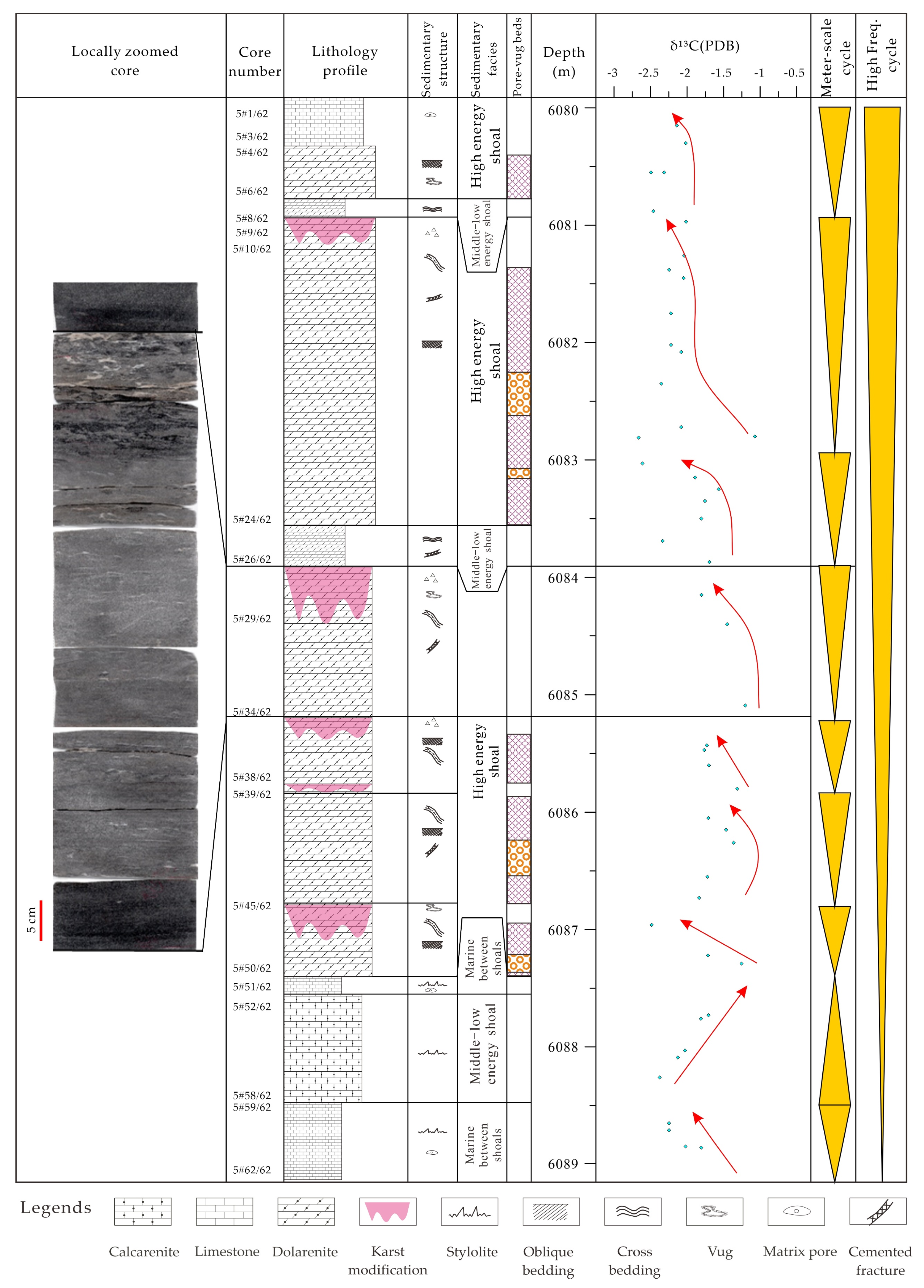
| Well No. | Analysis | Amount | Result Range |
|---|---|---|---|
| GC 601 | C-O isotope | 396 | δ13C: −2.802%~−0.537% δ18O: −13.917%~−4.085% |
| 87Sr/86Sr | 73 | 0.708896~0.712001 | |
| δCe | 40 | −0.0746~0.0287 | |
| GC 17 | C-O isotope | 151 | δ13C: −2.927%~−0.740% δ18O: −10.190%~−5.909% |
| 87Sr/86Sr | 12 | 0.708927~0.710174 | |
| δCe | 12 | −0.0456~−0.0031 |
Publisher’s Note: MDPI stays neutral with regard to jurisdictional claims in published maps and institutional affiliations. |
© 2022 by the authors. Licensee MDPI, Basel, Switzerland. This article is an open access article distributed under the terms and conditions of the Creative Commons Attribution (CC BY) license (https://creativecommons.org/licenses/by/4.0/).
Share and Cite
Lin, T.; Zhu, K.; Zhang, Y.; Feng, Z.; Zheng, X.; Li, B.; Yi, Q. High-Frequency Sea-Level Cycle Reconstruction and Vertical Distribution of Carbonate Ramp Shoal Facies Dolomite Reservoir in Gucheng Area, East Tarim Basin. Energies 2022, 15, 4287. https://doi.org/10.3390/en15124287
Lin T, Zhu K, Zhang Y, Feng Z, Zheng X, Li B, Yi Q. High-Frequency Sea-Level Cycle Reconstruction and Vertical Distribution of Carbonate Ramp Shoal Facies Dolomite Reservoir in Gucheng Area, East Tarim Basin. Energies. 2022; 15(12):4287. https://doi.org/10.3390/en15124287
Chicago/Turabian StyleLin, Tong, Kedan Zhu, You Zhang, Zihui Feng, Xingping Zheng, Bin Li, and Qifan Yi. 2022. "High-Frequency Sea-Level Cycle Reconstruction and Vertical Distribution of Carbonate Ramp Shoal Facies Dolomite Reservoir in Gucheng Area, East Tarim Basin" Energies 15, no. 12: 4287. https://doi.org/10.3390/en15124287





